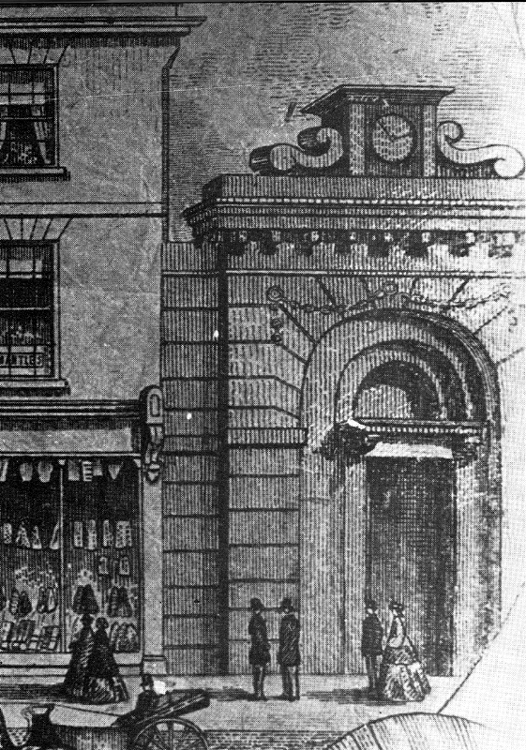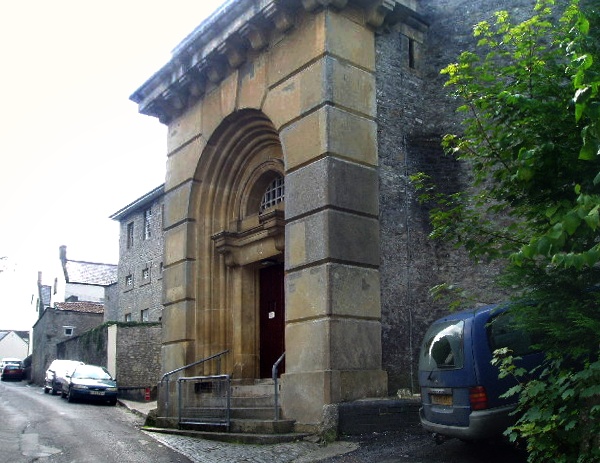Fore Street
Number 7 Fore Street was, from around 1778, the location of Bridgwater’ Gaol. The Gaol moved to the police station at the junction of High Street and Clare Street in 1875. The Lipton’s shop frontage (see below) was built about that time, although parts of the gaol and its fixtures remained behind (see the 1946 description below). The whole site was demolished in 1966 by the West Somerset and East Devon Cooperative Society as part of their supermarket development.
The Gaol had probably occupied this site from about 1778, when a smaller gaol, the ‘Cockmoyle’ was demolished, which was located on part of the site now occupied by the back of the Cornhill market house. The Gaol had three bells, details of which can be found here. The gaol also contained a strongroom for the Borough Archives. The Gaol property was also the site of the Cross Keys Inn, although how the two functioned together is not yet clear.
The prison reformer James Neild (1744-1814) visited Bridgwater to inspect the Gaol, and described it in his State of the prisons in England, Scotland, and Wales: extending to various places therein assigned, not for the debtor only, but for felons also, and other less criminal offenders. Together with some useful documents, observations, and remarks, adapted to explain and improve the condition of prisoners in general (1812), page 50:
BRIDGEWATER. Somersetshire.
The Town Gaol.
Gaoler, Samuel Brevitt, now Samuel Slocomb: He is a Sergeant at Mace. Salary, none. Fees, both Debtors and Felons, 3s. 4d.
No. of Prisoners, 1803, Oct. 5th, Debtors, none. Felons and Petty Offenders, One. 1806, Sept. 2nd., Debtors, none. Felons and Petty Offenders, One.
Allowance to Debtors, none. Felons and other Criminal Prisoners, fourpence half-penny, or sixpence per day, as bread is cheap or dear.
The Gaol is within the Cross-Keys Publick-House, situate near the bridge: The entrance is down a long passage, over which are the Council Chamber and Sessions House. It consists of one room for Men, about 15 feet square, with two iron-grated windows, and straw for sleeping on the floor. Here is also another room for Women, nearly of the same size, with a fire-place and boarded floor; and a third, with a fire-place, is used as a workshop.
Up-stairs are three rooms; in one of which there are five beds, furnished by the Keeper, at 1s. or 1s. 6d. per week, if two sleep together; or at 2s. per week for each single bed.
No Debtors are sent hither, but by process issuing out of the Borough Court, and then commitable for sums to any amount.
Here is one very small court-yard, with a sewer in it, a pump, and a pig sty. Water is brought to the Prisoners as they want it. The straw for bedding is changed once a fortnight. No Rules and Orders.
George Parker wrote a poem for a fund-raising exhibition in the Town Hall to help pay for the Restoration of St Mary’s Church. It took place in November 1854. In the Notes is the following passage:
A handsome cross once stood on the Corn Hill. Between it and the Bridge stands the old Jail, over which is a clock; some years since the hours were struck by two large antiquated wood figures on two excellent bells. They held in their hands a sort of battle axe, and their arms were moved by means of springs. When the old Town Hall [this same building] which stood there was removed, and the building became altered, these figures were taken down and sold by order of the authorities, which is to be regretted. I have heard, at some Election freak, a platform was made at night upon the Cornhill, and those two figures craftly removed there; where, in the morning, they appeared dressed as representing two of the Candidates.
The Gaol frontage was then rebuilt in 1834:

The 1834 frontage was designed by Richard Carver, who also designed Bridgwater’s Town Hall and Holy Trinity Church. Bridgwater Gaol’s facade was almost identical, aside from its clock, to the portal of Shepton Mallet Gaol, also designed by Carver in 1830. Carver’s plans (wrongly dated to 1854) can be found at the Somerset Heritage Centre, reference Q/RUP/240a. Carver was also responsible for the County Court building in Queen Street, built in 1824.

Bath Chronicle and Weekly Gazette 11 October 1849
ESCAPE FROM BRIDGWATER GAOL
On Thursday, another escape was made front this gaol. A man was put to sleep in a room with two other prisoners, but during the night, with the assistance of his companions, he managed to make a hole in the ceiling of his room, which it of lath and plaster, and by that means got on the roof and got clear off, with nothing on but his shirt. This is the second or third escape within a very recent period. It if the more provoking, as Inspector Hill had used much labour, ingenuity, and exertion in capturing the fellow; and it was not till the last moment, as he was about leaving by the train, that he was apprehended.
Powell’s Bridgwater in the Later Days, 1908
(p.196)…there was always the fear of the old gaol in Fore Street. This solemn looking building was adorned in front with a festoon of fetters or gyves, well calculated to strike terror into the hearts of evil doorers. Four of the gaol-keepers are still remembered: Mr Green, Mr Gover, Mr James Bussell, and Mr Thomas Lear, who afterwards became superintendent of the police. Part of the old gaol wall is still standing, and can be seen behind Messrs Bond’s premises in Fore Street near the bridge.
Taunton Courier and Western Advertiser 11 September 1943
OLD BRIDGWATER GAOL
The correspondence regarding the period when the Somerset Assizes were held in Bridgwater has brought to light some interesting facts about the old Bridgwater Gaol. It stood in Fore Street on the site of Messrs. Lipton’s shop and extended back as far as the premises now used as St. George’s R.C. School. When the provision shop was built, however, only the front part of the site was used, the remainder of the gaol being left intact without an entrance, and in that state it remains today, except that the cells at the extreme end were demolished by Mr H. H. Mellows, butcher, Fore Street, who acquired the property in order to extend the accommodation in his yard. The stone outer walls of the gaol are of massive size, the one at the rear being about a yard and a half thick. Inside are several rooms, now in a state of dilapidation, with the exception of the detention room, which still contains the rings and chains by which prisoners were fastened. Most of the hand-wrought iron grilles over the window spaces are still in position. Relics of the gaol preserved at the Blake Museum are the three bells on which the gaol clock struck the hours, and a piece of glass from one of the cells on which a prisoner scratched his name. According to Colonel Edward Trevor, whose family has been connected with the legal profession in the town for about 150 years, the Assizes were at one time held in the gaol, and his father, when a boy, was taken to the gaol to see the body of a man who had just been hanged there.
Lott’s and Lipton’s

In 1876 the old gaol site was taken over by the Lott family of drapers, who lived next door towards the river. They demolished the old gaol that December in order to build a new shop with accommodation above. A report in the Bridgwater Mercury of 20th December 1876 describes how most of the site had been demolished and a foundation stone was laid in the presence of the mayor, and a time capsule added. The architect of the new buildings were Edwin Down and Son, while the builders were Messrs Chedzoy and Son. The new tenant for the property would be Mr O’Brien, fishmonger. With thanks to Clare Spicer for filling out these details, a full biography of the Lotts can be read on the website of the Friends of the Wembdon Road Cemetery.
This building was demolished in 1966 as part of the wider Cooperative retail and flats development.
